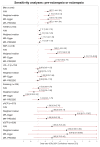Maternal Hypertension Increases Risk of Preeclampsia and Low Fetal Birthweight: Genetic Evidence From a Mendelian Randomization Study
- PMID: 35138876
- PMCID: PMC7612410
- DOI: 10.1161/HYPERTENSIONAHA.121.18617
Maternal Hypertension Increases Risk of Preeclampsia and Low Fetal Birthweight: Genetic Evidence From a Mendelian Randomization Study
Abstract
Background: Maternal cardiovascular risk factors have been associated with adverse maternal and fetal outcomes. Given the difficulty in establishing causal relationships using epidemiological data, we applied Mendelian randomization to explore the role of cardiovascular risk factors on risk of developing preeclampsia or eclampsia, and low fetal birthweight.
Methods: Uncorrelated single-nucleotide polymorphisms associated systolic blood pressure (SBP), body mass index, type 2 diabetes, LDL (low-density lipoprotein) with cholesterol, smoking, urinary albumin-to-creatinine ratio, and estimated glomerular filtration rate at genome-wide significance in studies of 298 957 to 1 201 909 European ancestry participants were selected as instrumental variables. A 2-sample Mendelian randomization study was performed with primary outcome of preeclampsia or eclampsia (PET). Risk factors associated with PET were further investigated for their association with low birthweight.
Results: Higher genetically predicted SBP was associated increased risk of PET (odds ratio [OR] per 1-SD SBP increase 1.90 [95% CI=1.45-2.49]; P=3.23×10-6) and reduced birthweight (OR=0.83 [95% CI=0.79-0.86]; P=3.96×10-18), and this was not mediated by PET. Body mass index and type 2 diabetes were also associated with PET (respectively, OR per 1-SD body mass index increase =1.67 [95% CI=1.44-1.94]; P=7.45×10-12; and OR per logOR increase type 2 diabetes =1.11 [95% CI=1.04-1.19]; P=1.19×10-3), but not with reduced birthweight.
Conclusions: Our results provide evidence for causal effects of SBP, body mass index, and type 2 diabetes on PET and identify that SBP is associated with reduced birthweight independently of PET. The results provide insight into the pathophysiological basis of PET and identify hypertension as a potentially modifiable risk factor amenable to therapeutic intervention.
Keywords: birth weight; blood pressure; body mass index; preeclampsia; risk factors.
Conflict of interest statement
DG is employed part-time by Novo Nordisk. All other co-authors have no relevant disclosures, and all authors declare there are no conflicts of interest in relation to this work.
Figures




Similar articles
-
Safety of beta-blocker and calcium channel blocker antihypertensive drugs in pregnancy: a Mendelian randomization study.BMC Med. 2022 Sep 6;20(1):288. doi: 10.1186/s12916-022-02483-1. BMC Med. 2022. PMID: 36064525 Free PMC article.
-
Mendelian randomization analysis does not support causal associations of birth weight with hypertension risk and blood pressure in adulthood.Eur J Epidemiol. 2020 Jul;35(7):685-697. doi: 10.1007/s10654-020-00638-z. Epub 2020 May 7. Eur J Epidemiol. 2020. PMID: 32383070 Free PMC article.
-
Mediating Factors in the Association of Maternal Educational Level With Pregnancy Outcomes: A Mendelian Randomization Study.JAMA Netw Open. 2024 Jan 2;7(1):e2351166. doi: 10.1001/jamanetworkopen.2023.51166. JAMA Netw Open. 2024. PMID: 38206626 Free PMC article.
-
Folic acid supplementation and malaria susceptibility and severity among people taking antifolate antimalarial drugs in endemic areas.Cochrane Database Syst Rev. 2022 Feb 1;2(2022):CD014217. doi: 10.1002/14651858.CD014217. Cochrane Database Syst Rev. 2022. PMID: 36321557 Free PMC article.
-
Serum uric acid levels as a causal factor in hypertension: Insights from Mendelian randomization analysis.Clin Exp Hypertens. 2025 Dec;47(1):2496514. doi: 10.1080/10641963.2025.2496514. Epub 2025 May 5. Clin Exp Hypertens. 2025. PMID: 40325623 Review.
Cited by
-
A novel GJA5 variant associated with increased risk of essential hypertension.Am J Transl Res. 2023 Feb 15;15(2):1259-1270. eCollection 2023. Am J Transl Res. 2023. PMID: 36915790 Free PMC article.
-
Using genetic association data to guide drug discovery and development: Review of methods and applications.Am J Hum Genet. 2023 Feb 2;110(2):195-214. doi: 10.1016/j.ajhg.2022.12.017. Am J Hum Genet. 2023. PMID: 36736292 Free PMC article. Review.
-
Hypertensive disorders of pregnancy and cardiovascular disease risk: a Mendelian randomisation study.Heart. 2024 Apr 25;110(10):710-717. doi: 10.1136/heartjnl-2023-323490. Heart. 2024. PMID: 38148158 Free PMC article.
-
Prediction of birthweight with early and mid-pregnancy antenatal markers utilising machine learning and explainable artificial intelligence.Sci Rep. 2025 Jul 19;15(1):26223. doi: 10.1038/s41598-025-11837-7. Sci Rep. 2025. PMID: 40683960 Free PMC article.
-
Investigating genetic links between blood metabolites and preeclampsia.BMC Womens Health. 2024 Apr 5;24(1):223. doi: 10.1186/s12905-024-03000-7. BMC Womens Health. 2024. PMID: 38580943 Free PMC article.
References
-
- Martin JA, Hamilton BE, Osterman MJK, Driscoll AK. Births: Final Data for 2018. Natl Vital Stat Rep. 2019;68(13):1–47. - PubMed
Publication types
MeSH terms
Grants and funding
LinkOut - more resources
Full Text Sources
Medical

